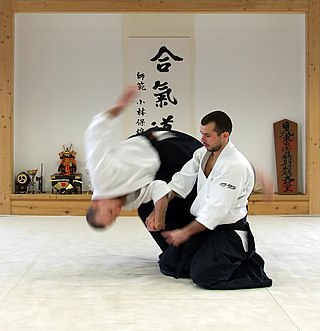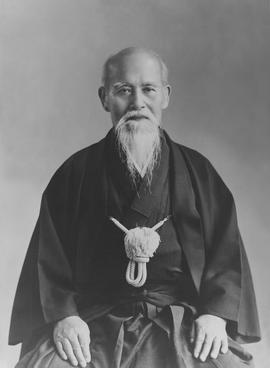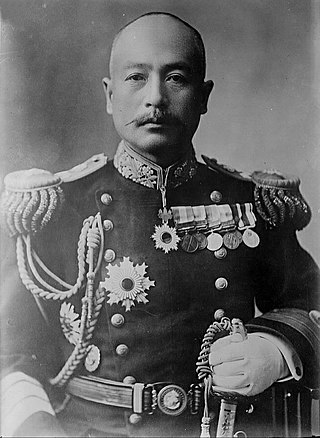
Aikido is a modern Japanese martial art that is split into many different styles, including Iwama Ryu, Iwama Shin Shin Aiki Shuren Kai, Shodokan Aikido, Yoshinkan, Renshinkai, Aikikai and Ki Aikido. Aikido is now practiced in around 140 countries. It was originally developed by Morihei Ueshiba, as a synthesis of his martial studies, philosophy and religious beliefs. Ueshiba's goal was to create an art that practitioners could use to defend themselves while also protecting their attackers from injury. Aikido is often translated as "the way of unifying (with) life energy" or as "the way of harmonious spirit". According to the founder's philosophy, the primary goal in the practice of aikido is to overcome oneself instead of cultivating violence or aggressiveness. Morihei Ueshiba used the phrase masakatsu agatsu katsuhayabi" to refer to this principle.

Morihei Ueshiba was a Japanese martial artist and founder of the martial art of aikido. He is often referred to as "the founder" Kaiso (開祖) or Ōsensei (大先生/翁先生), "Great Teacher".

Daitō-ryū Aiki-jūjutsu, originally called Daitō-ryū Jujutsu, is a Japanese martial art that first became widely known in the early 20th century under the headmastership of Takeda Sōkaku. Takeda had extensive training in several martial arts and referred to the style he taught as "Daitō-ryū". Although the school's traditions claim to extend back centuries in Japanese history there are no known extant records regarding the ryū before Takeda. Whether Takeda is regarded as either the restorer or the founder of the art, the known history of Daitō-ryū begins with him. Takeda's best-known student was Morihei Ueshiba, the founder of Aikido.

The Aikikai is the original school of Aikido. It is centered on the Aikikai Foundation in Japan, and its figurehead is the Doshu. It is represented globally through the International Aikido Federation.
Kisshomaru Ueshiba was a prominent Japanese master of aikido. He was the son of Morihei Ueshiba, founder of aikido, and became the international leader of aikido after his father's death.
Gozo Shioda was a Japanese master of aikido who founded the Yoshinkan style of aikido. He was one of aikido founder Morihei Ueshiba's most senior students. Shioda held the rank of 10th dan in aikido.
Kenji Tomiki was a Japanese martial artist who specialized in aikido and judo family of martial arts. He was a pedagogue of martial arts theory. He is the founder of Japan Aikido Association and the competitive aikido style.
Robert Nadeau is an American aikido teacher holding the rank of 8th dan and master teacher(Shihan) in the Aikikai. Nadeau began training in martial arts at the age of 16 and began studying Aikido with American instructor Robert Tan.
Seiseki Abe was a Japanese shodo and aikido teacher who had a unique relationship with aikido founder Morihei Ueshiba, being both his student in aikido and his teacher in calligraphy.

Isamu Takeshita was an admiral in the Imperial Japanese Navy. He was also a diplomat whose accomplishments included helping end the Russo-Japanese War favorably for Japan and obtaining former German possessions in the Pacific for Japan following World War I. In addition, he was a patron and practitioner of the Japanese martial arts, especially judo, sumo, and aikido.
Minoru Hirai was a Japanese martial artist and creator of the korindo style of aikido.

Prince Tokugawa Iesato was the first head of the Tokugawa clan after the overthrow of the Tokugawa shogunate, and a significant figure in Japanese politics and diplomacy during the Meiji, Taishō and early Shōwa period Japan. When Prince Tokugawa travelled to other nations representing Japan during his diplomatic journeys, he usually presented his name as Prince Iyesato Tokugawa. Prince Tokugawa held the influential position of president of Japan's upper house of congress the Diet for 30 years. Tokugawa promoted democratic principles and international goodwill. It was only after his death in 1940 that Japanese militants were able to push Japan into joining the Axis Powers in WWII.
Though the art of aikido is characteristically different from other Japanese martial arts, it has a variety of identifiable styles within the family of organizations descending from the teachings of Morihei Ueshiba.
Kinomichi (氣之道) is a martial art in the tradition of budō, developed from the Japanese art aikido by Masamichi Noro and founded in Paris, France, in 1979. Masamichi Noro was one of the live-in students (uchideshi) of Morihei Ueshiba, the founder of aikido. Designated "Delegate for Europe and Africa" by Morihei Ueshiba, Noro debarked in Marseille on September 3, 1961, preceding Nakazono and Tamura in the communal construction of a European and African aikido. In France, Kinomichi is affiliated with the Fédération Française d’Aïkido, Aïkibudo, Kinomichi et disciplines Associées (FFAAA) and maintains warm relations with the Aikikai Foundation and its leader, Moriteru Ueshiba, the grandson of aikido’s founder.

Kokusai Budoin, International Martial Arts Federation (IMAF) is the oldest continuously operating Japanese organization promoting international Budō. The organization, founded in 1952, has headquarters in Tokyo, Japan and is a member of the United Nations Department of Economic and Social Affairs.
Aikido concepts are ideas that form the philosophical or technical basis of the Japanese martial art aikido.

International Aikido Federation is a world governing body for the sport of Aikido.
Tsutomu Yukawa was a Japanese aikidoka.
Alan Ruddock was an Irish Martial Arts pioneer, teacher and writer. He introduced both Aikido & Karate to Ireland and was the founder of the Aiki no Michi and its interpretation of Aikido. Ruddock was one of the few western Aikido practitioners and only Irish national who studied directly under the founder of Aikido, Morihei Ueshiba ("O-Sensei").

Stanley A. Pranin was an American martial artist, founding publisher, and editor-in-chief of Aikido Journal. Pranin, a researcher and archivist of aikido, has written and published several books and many articles about aikido, Daito-ryu Aikijujutsu, and Morihei Ueshiba and was an influential figure in the aikido world.








